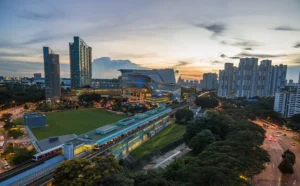Did you know that the real estate market in India is projected to reach US$ 1 trillion in market size by 2030, up from US$ 200 billion in 2021, and contribute 13% to the country’s GDP by 2025? Also, this sector is the second-largest employment generator in the country. In light of these facts, it is no surprise that demand for real estate in the country is booming, with the sector seemingly unphased by the global pandemic that shook the world. Rather than mirroring the global economy’s downward trajectory, the Indian real estate market has adeptly reimagined the built environment space, with demand surging for residential assets that are modern yet affordable in nature.
Table of Contents
The rapid urbanisation and increasing income of the middle class are just some of the many reasons why the country is among the top 10 price-appreciating housing markets internationally. However, a major reason behind the robust nature of the Indian real estate market is the concentrated efforts made by government agencies to revolutionise the infrastructure in the country. The booming cityscape of New Gurugram is a great example of the fruit of this labour.
Conscient of the success of the city of Gurugram and the dilemma of rising property costs and the saturation of this market, the government undertook the project to develop the peripheral area around Central Gurugram, known as New Gurugram. Developed according to the Gurugram-Manesar Plan 2021, the region today consists of Sectors 76 to 95 and 95A, and 102 to 113. The area has risen to prominence in the last half decade due to its strategic location, seamless connectivity to employment hubs, and the development of a vast array of residential projects. Let us delve into the various factors at play that are driving this micromarket into one of the most coveted real estate hubs in the country.
Rising Residential Demand
The residential real estate market has undergone a transformative shift in recent years. This is due to a number of reasons, one of which is the entrance of millennials into the housing market. The millennial generation currently makes up about 34% of India’s population, and with this generation being more inclined than ever to purchase homes, the residential real estate market is witnessing an all-time high. This is reflected in the fact that homebuying activity among millennials accounted for over 50% of house purchases in 2020.
The reason behind this rising demand is multi-pronged, with forces such as rising income levels and disposal income and the shift to a hybrid or work-from-home model playing a huge role. Further, with the pandemic leading to people having to suddenly contend with insecurity with regards to their living spaces, the desire to own their living spaces has never been higher. It is here that the cityscape of New Gurugram presented itself as the ideal solution.
While property rates in major metropolises such as Delhi, Mumbai, and Gurugram surge, New Gurugram, with its diverse options for residential spaces, presents itself as an affordable option. It is no wonder then that in a short period of time, this area has already become home to over 1 lakh dwellings, with 10,000–12,000 units currently under development. The micromarket’s proximity to major employment hubs, its strategic location, and its robust infrastructure have led to an average property in New Gurugram witnessing an appreciation of 5% during the last four years, according to ANAROCK Research.
Robust Infrastrcuture and Commercial Hub
It is a well-known fact that the infrastructure of an area is a decisive factor in its development and investment potential. Ideally, for an area to be labelled as a high-award investment arena, it has to have a robust social infrastructure in addition to possessing a well-developed transit framework. To break it down, this means that having top-of-the-line social institutions like schools, hospitals, recreational avenues, etc. is a must when it comes to fully capitalising on the investment potential of any area. Further, the area must be well-connected with a progressive network of public transport systems as well as road and highway connectivity that enables seamless transit.
The micromarket of New Gurugram excels in both of these areas. From New Gurugram’s wide roads to its storm water drainage system to its underground electric cable network, the entire locale has been planned with utmost care for intricate details in accordance with the guidelines laid out in the Gurugram-Manesar Plan 2021. Furthermore, the micromarket is strategically located between Millenium City and Manesar and promises easy access to the IT and industrial/business hubs located in both cities.
Situated in proximity to major arterial roadways such as the Dwarka Expressway, NH-48, Pataudi Road, and Kundli-Manesar-Palwal Expressway, the micromarket promises 360° connectivity to Delhi NCR. The micromarket is merely 20 minutes away from the industrial towns of Dharuhera and Bhiwadi and is a meagre 5 minutes away from Industrial Model Township Manesar. With the imminent completion of the Dwarka Exressway and Central Peripheral Road, the micromarket is primed to transform into a connected ecosystem. The locale has already started to attract the attention of major developers and is currently home to numerous multinational corporations.
In addition to possessing a thriving commercial catchment, the locale is also drawing the attention of retailers who are keen to cash in on this booming landscape. The rapidly growing consumer base, with an existing ecosystem of approximately 5 lakh people, is strategically pivoted to shoot into one of the most prestigious and propitious investment zones in the country.
Investing in Sector 84, Gurugram: A Lucrative Opportunity
Today, Sector 84 in New Gurugram presents a compelling investment opportunity for individuals seeking to maximise their returns. From its strategic location to its robust infrastructure and promising development prospects, Sector 84 offers several advantages for investors. Whether you are a seasoned investor or a first-time buyer, the sector provides you with tremendous potential for growth, attractive property prices, and a vast range of amenities and facilities, making it an enticing destination for investment.
Situated close to major business hubs, educational institutions, and healthcare facilities, Sector 84 provides convenience and excellent connectivity. The area’s well-planned roads, and modern amenities contribute to its appeal. With rapid development and upcoming infrastructure projects, Sector 84 is primed for property price appreciation. It offers a range of residential and commercial projects to suit various budgets.
Moreover, the presence of schools, hospitals, shopping centres, and recreational spaces adds to the area’s desirability. Investing in Sector 84 ensures access to a wide array of amenities. Whether seeking long-term capital appreciation or rental income, Sector 84 presents a lucrative opportunity. Its growth potential and attractive property prices make it an ideal choice for those looking to maximise their returns. Secure a prosperous future by investing in Sector 84, Gurugram.








